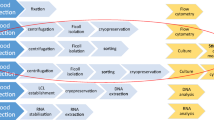Abstract
To observe the differences in proteins between adult patients with chronic immune thrombocytopenic purpura (ITP) and healthy adults. 30 patients with chronic ITP and 30 healthy controls were enrolled into the study. The platelet total protein was extracted from peripheral venous blood of 10 chronic ITP patients and 10 healthy controls respectively, and subjected to two-dimensional electrophoresis (2-DE) to find the differential protein spot between chronic ITP patients and healthy controls, then the differential protein spots were identified by mass spectrometry. Subsequently, platelets RNA and proteins were isolated from the other 20 chronic ITP patients and 20 healthy controls respectively, and used for confirming the 2-DE and mass spectrometry results by using reverse transcription-quantitative polymerase chain reaction (RT-qPCR) and enzyme linked immunosorbent assay (ELISA). 2-DE combined with mass spectrometry revealed that calreticulin (CRT) expressed normally within platelets from healthy controls, while it reduced within platelets from patients with chronic ITP. qPCR and ELISA confirmed that CRT was decreased at both RNA transcription and protein expression levels within platelets from chronic ITP patients compared with healthy controls. Decreased transcription and expression of CRT within platelets may play an important role in the pathogenesis of chronic ITP, which is worthy of further study.



Similar content being viewed by others
References
Palaniappan G, Jennings W (2009) Idiopathic thrombocy-topenic purpura. Mo Med 106(1):69–73
Wong CS, Wong VW, Chan CM, Ma BB, Hui EP, Wong MC, Lam MY, Au TC, Chan WH, Cheuk W, Chan AT (2008) Identification of 5-fluorouracil response proteins in colorectal carcinoma cell line SW480 by two-dimensional electrophoresis and MALDI-TOF mass spectrometry. Oncol Rep 20(1):89–98
Uljon SN, Treon SP, Tripsas CK, Lindeman NI (2013) Challenges with serum protein electrophoresis in assessing progression and clinical response in patients with Waldenström macroglobulinemia. Clin Lymphoma Myeloma Leuk 13(2):247–249
Chevallet M, Luche S, Rabilloud T (2006) Silver staining of proteins in polyacrylamide gels. Nat Protoc 1(4):1852–1858
Li HH, Su JH, Chiu CC, Lin JJ, Yang ZY, Hwang WI, Chen YK, Lo YH, Wu YJ (2013) Proteomic investigation of the sinulariolide-treated melanoma cells A375: effects on the cell apoptosis through mitochondrial-related pathway and activation of caspase cascade. Mar Drugs 11(7):2625–2642
Sudchada P, Oo-puthinan S, Kerdpin O, Saelim N (2010) ABCB1 gene expression in peripheral blood mononuclear cells in healthy Thai males and females. Genet Mol Res 9(2):1177–1185
Coppolino MG, Dedhar S (1998) Calreticulin. Int J Biochem Cell Biol 30(5):553–558
Raghavan M, Wijeyesakere SJ, Peters LR, Del Cid N (2013) Calreticulin in the immune system: ins and outs. Trends Immunol 34(1):13–21
Baksh S, Michalak M (1991) Expression of calreticulin in Escherichia coli and identification of its Ca2+ binding domains. J Biol Chem 266:21458–21465
McCauliffe DP, Zappi E, Lieu TS, Michalak M, Sontheimer RD, Capra JD (1990) A human Ro/SS-A autoantigen is the homologue of calreticulin and is highly homologous with onchocercal RAL-1 antigen and an aplysia “memory molecule”. J Clin Invest 86(1):332–335
Gardai SJ, McPhillips KA, Frasch SC, Janssen WJ, Starefeldt A, Murphy-Ullrich JE, Bratton DL, Oldenborg PA, Michalak M, Henson PM (2005) Cell-surface calreticulin initiates clearance of viable or apoptotic cells through trans-activation of LRP on the phagocyte. Cell 123(2):321–334
Gold LI, Eggleton P, Sweetwyne MT, Van Duyn LB, Greives MR, Naylor SM, Michalak M, Murphy-Ullrich JE (2010) Calreticulin: non-endoplasmic reticulum functions in physiology and disease. FASEB J 24(3):665–683
Tarr JM, Young PJ, Morse R, Shaw DJ, Haigh R, Petrov PG, Johnson SJ, Winyard PG, Eggleton P (2010) A mechanism of release of calreticulin from cells during apoptosis. J Mol Biol 401(5):799–812
Alur M, Nguyen MM, Eggener SE, Jiang F, Dadras SS, Stern J, Kimm S, Roehl K, Kozlowski J, Pins M, Michalak M, Dhir R, Wang Z (2009) Suppressive roles of calreticulin in prostate cancer growth and metastasis. Am J Pathol 175(2):882–890
Machlus KR, Thon JN, Italiano JE Jr (2014) Interpreting the developmental dance of the megakaryocyte: a review of the cellular and molecular processes mediating platelet formation. Br J Haematol 165(2):227–236
Elton CM, Smethurst PA, Eggleton P, Farndale RW (2002) Physical and functional interaction between cell-surface calreticulin and the collagen receptors integrin alpha2beta1 and glycoprotein VI in human platelets. Thromb Haemost 88(4):648–654
Reilly D, Larkin D, Devocelle M, Fitzgerald DJ, Moran N (2004) Calreticulin-independent regulation of the platelet integrin alphaIIbbeta3 by the KVGFFKR alphaIIb-cytoplasmic motif. Platelets 15(1):43–54
Dubois C, Panicot-Dubois L, Merrill-Skoloff G, Furie B, Furie BC (2006) Glycoprotein VI-dependent and -independent pathways of thrombus formation in vivo. Blood 107(10):3902–3906
Jardín I, López JJ, Pariente JA, Salido GM, Rosado JA (2008) Intracellular calcium release from human platelets: different messengers for multiple stores. Trends Cardiovasc Med 18(2):57–61
Wang Z, Li S, Shi Q, Yan R, Liu G, Dai K (2010) Calmodulin antagonists induce platelet apoptosis. Thromb Res 125(4):340–350
Bishop-Bailey D (2010) The platelet as a model system for the acute actions of nuclear receptors. Steroids 75(8–9):570–575
Funding
This work was supported by Natural Science Foundation of Guangdong Province, China (Nos. 9151802904000008 and S2011010004982).
Author information
Authors and Affiliations
Corresponding author
Ethics declarations
Ethical Approval
This study was approved by the ethical review committee of the Second Affiliated Hospital of Shantou University Medical College.
Rights and permissions
About this article
Cite this article
Yung, K.C., Zhang, Z.W., Yu, W.J. et al. Study on the Role of Calreticulin Within Platelet from Adult Patients with Chronic Immune Thrombocytopenic Purpura. Indian J Hematol Blood Transfus 34, 711–718 (2018). https://doi.org/10.1007/s12288-018-0955-8
Received:
Accepted:
Published:
Issue Date:
DOI: https://doi.org/10.1007/s12288-018-0955-8




